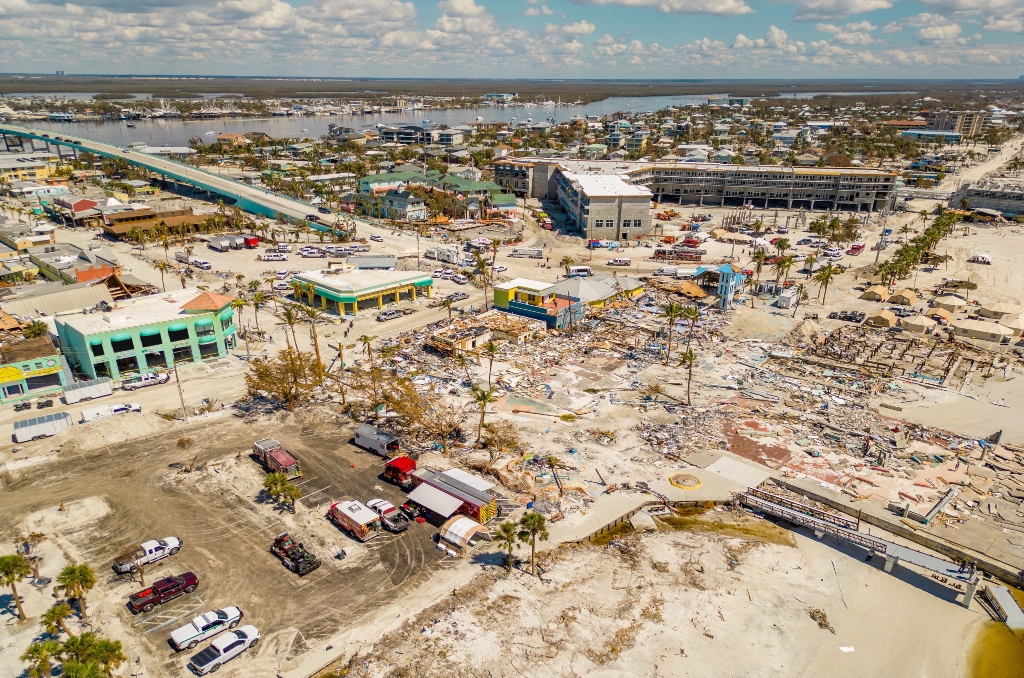Destruction caused by Hurricane Ian in Fort Myers, FL – Courtesy: Shutterstock – Image by Felix Mizioznikov
Hurricane Ian, a Category 4 storm with sustained winds of more than 150 mph, made landfall on Cayo Costa, a barrier island northwest of Cape Coral and Fort Myers, Florida, on September 28. In Florida, it was the deadliest hurricane since 1935, killing 149 people. On Fort Myers Beach, multistory oceanfront apartment complexes are still merely mounds of twisted steel and concrete ruins, and enormous shrimping boats sit tilted and smashed together like toys in the corner of a tub, evidence of the storm’s immense strength persists more than four months later.
The entire west coast of Florida was subject to the storm’s fury. But Sanibel Island, one of the most well-liked vacation spots in the region, was particularly heavily struck. The 12-mile-long and three-mile-wide fish-hook-shaped barrier island was completely destroyed. In fact, a portion of the causeway connecting it to the mainland was demolished.
The mayor of Sanibel, Holly Smith, 61, was direct one recent afternoon as she sat at a table outside the Sanibel Grill, which had been closed for months due to roof and water damage. “There’s no spring break here,” she said. “As far as the recovery of tourism, we have a long way to go.”
Smith said that during the storm, the island had “a complete washover”—the 12-foot storm surge covered everything.
A homeowner on the island, Beth Sharer, 66, claimed that when she returned to her destroyed property, she was unable to locate the high-water mark that flooding typically leaves behind. The water was higher than the entire apartment, she added, so I understood there wasn’t one.
The area resembled a war zone when Ms. Smith visited the island with Gov. Ron DeSantis in the days following the storm, according to her. “It was like ‘Mad Max,’ with dirt across the roads.”
According to the Sanibel & Captiva Islands Chamber of Commerce, Sanibel and Captiva, a smaller island connected to Sanibel to the north by a brief bridge, had an estimated 2,800 lodging units, including hotel rooms and short-term rentals. Just 155 positions are open right now, according to the chamber. The chamber is now urging visitors to sign up for “voluntourism” options like helping to clear trails at the nature reserve or clean debris from the beaches. According to John Lai, the chamber’s chief executive, “We’ve changed our communication strategy from promoting the island to helping manage guest expectations for the next 12 months.”
According to the Lee County administration, Fort Myers Beach had 2,384 hotel rooms before to the storm. None of those rooms were accessible after the storm. Only 360 of those rooms—or 15 percent of the inventory before the hurricane—were still accessible as of this month.
Stories that matter are our priority. At Florida Insider, we make sure that the information we provide our readers is accurate, easy-to-read, and informative. Whether you are interested in business, education, government, history, sports, real estate, nature or travel: we have something for everyone. Follow along for the best stories in the Sunshine State.

Born and raised in South Florida, Krystal is a recent graduate from the University of Miami with professional writing experience at the collegiate and national news outlet levels. She’s a foodie who loves all things travel, the beach, & visiting new places throughout Florida.

